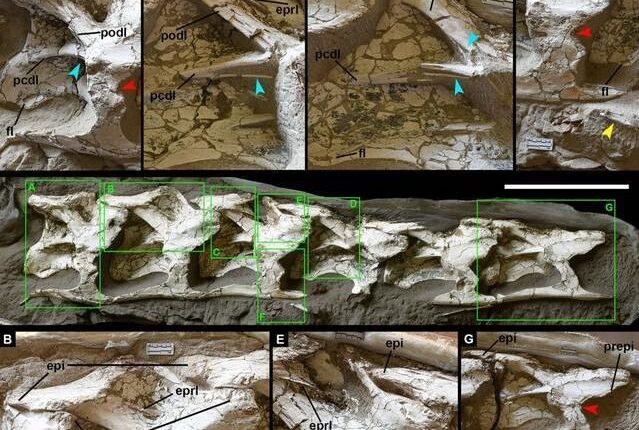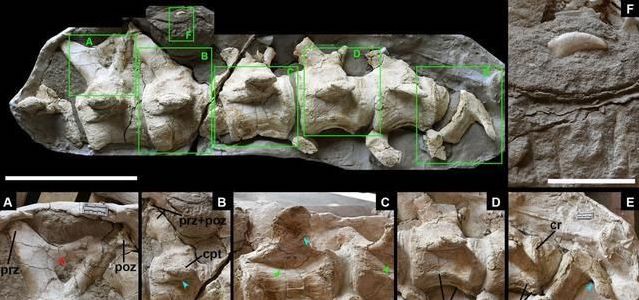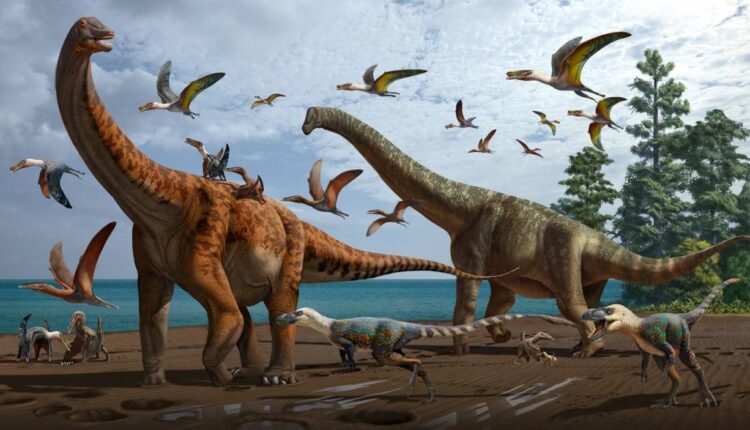The first dinosaurs from the Early Cretaceous Hami Pterosaur Fauna, China, reports the latest research results of dinosaur fossils “Chinese Silk Road Dragon” in the early white pterosaur fauna of Xinjiang . The three dinosaur fossils reported this time belong to Somphospondylan, which are incomplete.
Chinese Silk Road Dragon : They preserve an associated cervical vertebrae, an associated tail vertebrae and a recommended vertebrae, and the teeth of a theropod dinosaur preserved with the tail vertebrae. According to the characteristics of the cervical vertebrae, a new genus of Euhelopodidae was established: Silutitan sinensis according to the characteristics of the tail vertebrae, a new genus of Titanosauria was established: Xinjiang Hamisaurus ( Hamititan xinjiangensis).
This is the first time that porous spinosaur dinosaurs have been reported in the Lower Cretaceous strata in Xinjiang, and also the first report on dinosaur fossils of Hami Pterosaur fauna. The study of Chinese Silk Road Giant Dragon and Xinjiang Hami Giant Dragon has increased the diversity of Hami Pterosaur fauna, and also increased the diversity of sauropod dinosaurs in the early white eus of China. The emergence of two porous vertebrae dinosaurs has provided new information for the evolution of this dinosaur group, further proving the wide diversity of porous spondylosaurus dinosaurs in Asia, such as Chinese Silk Road Dragon.
Porous vertebratesaurs are one of the sauropod dinosaur Titanosauriformes, which lived from the late Jurassic to the late Cretaceous. They are rich in diversity and their fossils have been found on all continents around the world. Most porous vertebralosaurs are large, such as Argentine dragons and Yellow River giant dragons, both more than 30 meters long. The main characteristics of porous vertebralosaurs include long neck and forelimbs, with at least 15 cervical vertebrae, unlike diplodocus with extremely long tails and short forelimbs; their teeth are rod-shaped, unlike brachiosaurs with spoon-shaped teeth Chinese Silk Road Dragon.
The phylogenetic relationship between species of porous spinosaurs is still controversial. Some researchers believe that porous spinosaurs consist of giantsaurs and several backbone species, including discopods. Others believe that porous spinosaurs are composed of only giantosaurs and several backbone species, and that porous sponops are not part of porous spinosaurs.

In recent years, the fossils of porous vertebralosaurs have been found and reported in some parts of China in the Cretaceous strata, mainly distributed in Gansu, Henan, Shandong, Liaoning, Guangxi and other regions. Among them, the fossils of Pangapod were first found in Mengyin, Shandong Province in the 1920s. Previously, no porporus vertebralosaur fossils have been found in the Baiyu series strata of Xinjiang.
The only sauropod dinosaur was an Asian-like dinosaur found in the Tuyulu group of the Lower Baiyulu in the Junggar Basin. Due to the fragmentation of specimens, its classification location and naming validity are still controversial.
Fossils found in Hami pterosaur fauna in the Early White Angian in Xinjiang Chinese Silk Road Dragon.
The newly studied dinosaur fossils were discovered by a Hami scientific expedition led by Wang Yulin, Researcher of the Institute of Vertebrate Paleontology and Paleoanthropology of the Chinese Academy of Sciences, in the Shengjinkou Formation of the Lower Baiyulu Group of the Tuha Basin, and were symbiotic and preserved with Hami Pterosaur fossils. Due to the long-term exposure of fossils to the Gobi region with extremely arid and strong sandstorms, the surface weathering and fragmentation is serious, the scientific team carried out rescue collection in 2008, 2013 and 2016, respectively.
Since 2006, the Hami scientific research team of the Institute of Paleovertebrate of the Chinese Academy of Sciences has carried out scientific research in Hamigobi for more than ten consecutive years, and found a rare Hami pterosaur fauna. This area has become the world’s largest and richest pterosaur fossil production area. Hundreds of millions of pterosaurs have flourished here. It is named The real pterosaur Garden of Eden. Through more than ten years of scientific investigation and rescue collection, a number of remarkable achievements have been made in pterosaur research.
Not only did it find the first three-dimensional preserved female and male pterosaur individuals, but also found a large number of 3D preserved pterosaur eggs and pterosaur embryos to coexist with them.
In 2014, in Current Biology, he covered a large number of young to adult female pterosaurs, named the first species in the Hami Pterosaur fauna, Tianshan Hami Pterosaur, and reported on the world’s first three-dimensional preserved pterosaur eggs, revealing Hami Pterosaur had a leather eggshell structure similar to that of the living reptile brocade snake, showing the pterosaur’s social life. In 2017, Science reported an important specimen preserved in the trinity of more than 200 pterosaur eggs, embryos and skeletons. Among them, 16 pterosaur eggs contain three-dimensional embryo fossils, which is the first time that 3D pterosaur embryos have been discovered in the world Chinese Silk Road Dragon.
Chinese Silk Road Dragon : Through bone histology and individual development studies, including embryos, it is believed that Hamipteraus has a fast-growing skeletal structure, belongs to a relatively early maturity development model, cannot fly after birth, and needs parental care. These findings and studies reveal the life history of pterosaur, a special flying reptile. .
Through years of fieldwork and evidence related to burial, sedimentary and stratigraphy, it is believed that these huge pterosaurs have experienced many White Angian lake storm events, resulting in the death of their clusters and rapid burials. The sauropod dinosaurs studied in this study are the first non-pterosaur vertebrates found in Hami Pterosaur fauna. They are all produced from a considerable level of Hami Pterosaur fossils, and the production sites of the three specimens are about 2-5 km apart.
The new dinosaurs were named Chinese Silk Road Dragon and Xinjiang Hami Dragon.
Due to the extremely serious weathering of the surface of the fossil exposure, only part of the broken vertebrae remains in the three specimens. After rescue collection, the technicians of the scientific research team made scientific repairs to the other side buried in the rock that did not expose the surface.
After repair, it showed that the three specimens were six related cervical vertebrae and cervical ribs, seven associated tail vertebrae and a broken recommended vertebrae, of which the first two specimens were named China Silk Road Dragon and Xinjiang Hami Giant.
The new dinosaur name comes from the fossil origin and the huge size of this kind of dinosaur, representing the discovery of such large dinosaurs in Hami, Xinjiang, China, which is also an important town on the Belt and Road Silk Road Economic Belt, in memory of China’s great Silk Road connecting the world since ancient times.
China’s Silk Road Dragon has preserved six relatively complete cervical vertebrae, which are 10-15 respectively. The length of a single cervical vertebrae is between 455-540 mm, and the total length of the six cervical vertebrae is about 3 meters. It is the corresponding cervical vertebrae level of the early white Shishi Pangapod found in Mengyin, Shandong Province, China (about 15 meters long). The average length is nearly twice, and it is conservatively estimated that the length of China’s silk road dragon is more than 20 meters.
Chinese Silk Road Dragon Its identification characteristics include the lateral abdominal fork of the posterior joint process-transverse process septum of the middle and posterior cervical vertebrae, the anterior fork of the vertebrae-transverse process posterior septum, the development of the ventral flange of the accessory process-transverse process septum, and the front and posterior contraction of the contact surface between the middle and posterior posterior cervical vertebrae and ribs. Detailed morphological observation shows that there is a thick superior-anterior joint process septum and drooping cervical ribs in the cervical vertebrae of China.
Compared with other discopodosaurs that preserve cervical vertebrae, the direction of the superior process-anterior joint process septum of the cervical vertebrae, the direction of the anterior joint process-transverse process diaphragm, the development degree of the cervical vertebrae lateral concavea, etc. There are obvious differences between signs and other known species. Along with the Chinese Silk Road Dragon, there is also a broken Hami Pterosaur jaw, indicating that these large giantosaurs lived in the sky and land of the White Enduric with Hamipterosaur.

Because there are many species in porous spinosaur dinosaurs, the phylogenetic research of predecessors has focused on different clades Chinese Silk Road Dragon.
The researchers selected the latest two phylogenetic matrices in 2019 to analyze the phylogenetic position of Hami’s newly discovered porous vertebralosaurs, among which Filippi and others focused on the phylogetic relationship of the whole giantosaurs, including porous vertebralosaurs, with a total of 83 species and 405 characteristics; Ma nnion, etc. focuses on the phylogen evolution of porous spinosaurs, which contains 120 species and 548 characteristics.
Because the recommended vertebrae fossils in the new specimen are relatively fragmented, there are fewer characteristics that can be used for identification. Only it can be confirmed that they belong to porous vertebras, so they are basically not considered in phylogeny.
In order to determine whether the cervical vertebrae and caudal vertebrae belong to the same type, the characteristics of the cervical vertebrae and caudal vertebrae are put into two matrices as a whole. This combination type forms a sister group with the genus Euheelopus, but the characteristics supporting this sister group are only the characteristics of the cervical vertebrae, while making it strictly combined. The Italian tree adds many unresolved multi-branch structures compared with the original results. Then the characteristics of the cervical vertebrae and the tail vertebrae are analyzed as two types.
In the analysis of both matrices, the Chinese Silk Road Dragon, represented by the cervical vertebra, forms a sister group with Discopodus, and has multiple characteristics to support, which means that it has a close relationship with the discopod.
Therefore, Chinese Silk Road Dragon belongs to the shiro. Xinjiang Hamisaurus, represented by the tail vertebrae, is located in the giant dragons in the analysis of both matrices, but the addition of Xinjiang Hami giants has increased the unresolved multi-branch structure of the whole giant dragons. At the same time, its own system position is also different in the analysis of the two matrices, so its further system position is not It can be confirmed that new fossil materials and further research are needed.

